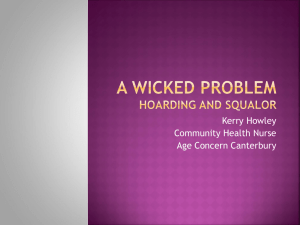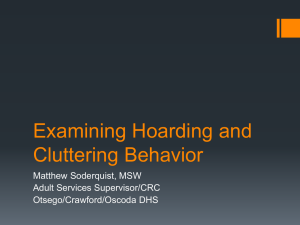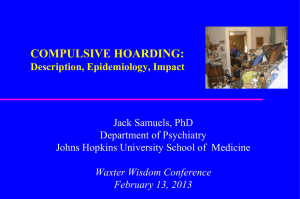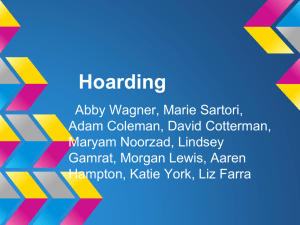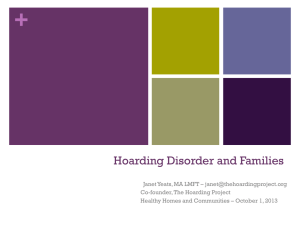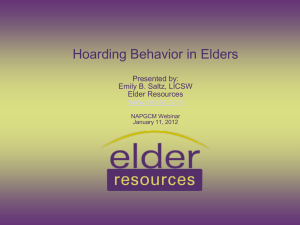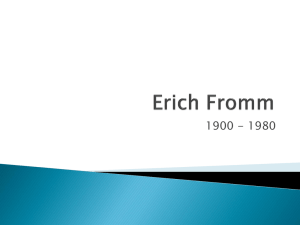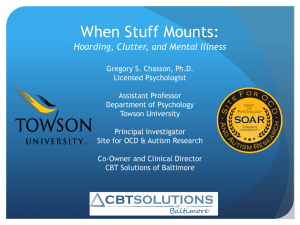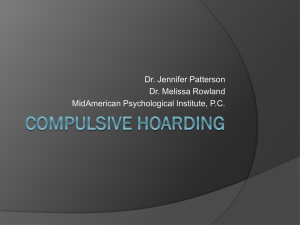Template Title Arial Narrow Bold
advertisement
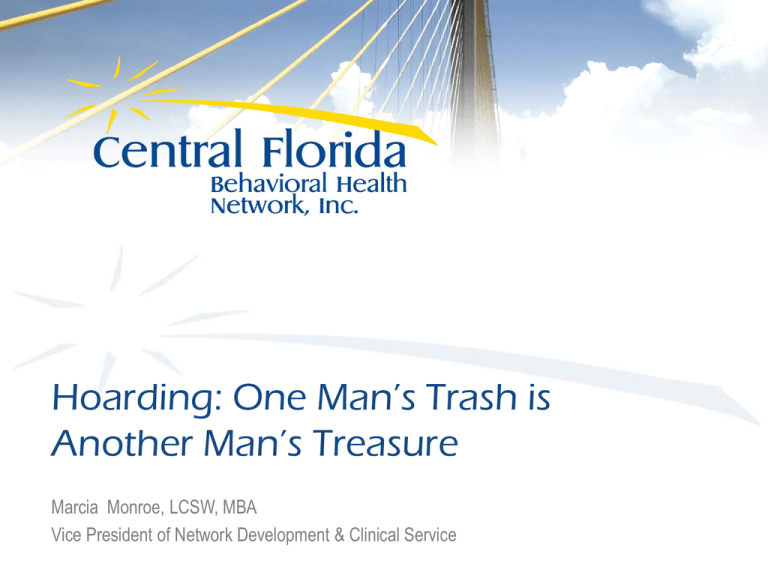
Hoarding: One Man’s Trash is Another Man’s Treasure Marcia Monroe, LCSW, MBA Vice President of Network Development & Clinical Service PERCEPTION DEFINITION & CHECKLIST Definition Hoarding is the name given to behavior that is characterized by: • The acquisition and failure to discard a large number of possessions that appear to be useless or of limited values • Accumulation of belongings to such a degree that they impact functions and/or preclude the activity for which the space was designed; for example, when a bed cannot be slept upon or a tub that cannot be used for bathing because they are used for storage • When the quantity of items creates a potential hazard or puts people at risk Checklist • • • • • • • • • • The “stuff” in your house is more than clutter You are unable to throw away possessions Your possessions have taken over your living space You cant use your appliances or plumbing fixtures anymore You feel embarrassed by your possessions Your suspicious of other people touching your possessions You cant pass up a bargain You are sure there is a treasure buried under piles of stuff You move stuff from pile to pile, but you don’t throw it away Your house smells bad and is dirty, but you cannot clean it up CRITERIA Diagnostic Criteria DSM-V A. B. C. D. E. F. Persistent difficulty discarding or parting with possessions, regardless of their actual value. This difficulty is due to a perceived need to save the items and to distress associated with discarding them The difficulty discarding possessions results in the accumulation of possessions that congest and clutter active living areas and substantially compromises their intended use. If living areas are uncluttered, it is only because of the interventions of third party (e.g. family members, cleaners, authorities). The hoarding causes clinically significant distress or impairment if social, occupational, or other important areas of functioning (including maintaining a safe environment of self and others)/ The hoarding is not attributable to another medical condition (e.g. brain injury, cerebrovascular disease, Prader-Willi syndrome). The hoarding is not better explained by the symptoms of another mental disorder 9e.g. obsessions in obsessive-compulsive disorder, deceased energy in major depressive disorder, delusions in schizophrenia or another psychiatric disorder, cognitive deficits in major neurocognitive disorder, restricted interests in autism spectrum disorder). PRESENTING PROBLEMS Related Presenting Problems Pending eviction Landlord harassment Problems with neighbors Complaints from the health or fire department Rejection by a home care agency because the need for heavy duty cleaning that the client refuses • Referred by neighbor, family, clergy. • • • • • DIAGNOSTIC FEATURES Diagnostic Features According to an article published in the Journal of Clinical Psychiatry, people who hoard have obsessive-compulsive disorder, other people who hoard do not. The frequent theme on hoarder reality shows is that the individual does not realize that their lifestyle has spiraled out of control. Those with the disorder are frequently characterized by poor insight about the severity of their condition, leading to resistance of attempt by others to intervene. As the Mayo Clinic notes, even if hoarders collections are disassembled, they often begin acquiring more items right away because their underlying condition has not been addressed. Contributing Factors Overestimate the need to remember or keep records…”I need….to remember” Catastrophic assessment of consequences of forgetting information…”I just know once I get rid of …..I will need it to….” Fear of making wrong decision…..”If I only knew for sure….” ASSOCIATED FEATURES SUPPORTING DIAGNOSIS Associated Features Supporting Diagnosis • Sentimental hoarders – collecting things that signify their life like a personal history or testimony • “Keep everything Steptoe's” whose collecting reflects varying needs including attachment, identify, worthwhile or helpful to others, impulsivity or compulsivity. • Keeping “just in case” hoarders just cannot leave anything or throw anything away • Hoarding of specific things – newspapers, books, animals, clothing – info, attachment, waste not, memory links • Those whose hoarding reflects cognitive decline, delusional symptoms and other dysfunctional behaviors PREVALENCE Prevalence – Age of Onset, Course • Chronic & insidious course becoming overwhelming. Single traumatic event can lead to hoarding. • Age of onset in childhood/early adolescence as young as 10, mild symptoms at 17, moderate in mid-20’s, extreme by mid-30’s • Hoarding more burdensome with age – 3 times more frequent age 55 and older than in 34-44 age. Help not generally sought until middle age. • Samuels (2008) estimated prevalence 5%, twice OCD, 5 times Panic Disorder & Schizophrenia • It is estimated that slightly less than 1% of the population hoards – approximately 3 million people in the US. • Hoarding is private and is in all likelihood underreported. Researchers believe that fewer than 5% of hoarders ever come to the attention of authorities. Prevalence – the Elderly Hoarding does not begin suddenly. It takes years for items to accumulate to such a degree that they constitute hoarding. Some experts believe that hoarding increases among older adults as compensation for accumulated human losses. Other believe that hoarding only seems to be a bigger problem among the elderly because they have had more time to accumulate. As more and more cases of extreme hoarding in older adults are revealed, hoarding among the elderly is being recognized as a significant problem. DEVELOPMENT & COURSE Development & Course Hoarding appears to begin early in life and spans will into the late stages. Hoarding symptoms may first emerge around ages 11-15 years, start interfering with the individuals everyday functioning by the mid20’s, and cause clinically significant impairment by the mid-30’s. participants in clinical research studies are usually in their 50’s. http://www.youtube.com/watch?v=TSaxn0a1Cbk RISK & PROGNOSTIC FACTORS Risk & Prognostic Factors • Temperamental: Indecisiveness is a prominent feature of individuals with hoarding disorder and their first degree relatives • Environmental: Individuals with hoarding disorder often retrospectively report stressful and traumatic life events preceding the onset of the disorder or causing an exacerbation • Genetic and Physiological: Hoarding behavior is familial, with about 50% of individuals who hoard reporting having a relative who also hoards. Twin studies indicate that approximately 50% of the variability in hoarding is attributable to addictive genetic factors. CULTURE RELATED DIAGNOSTIC ISSUES Culture Related Diagnostic issues While most of the research has been done in Western, industrialized countries and urban communities, the available data from non-Western and developing countries suggest that hoarding is a universal phenomenon with consistent clinical features. GENDER RELATED DIAGNOSTIC ISSUES Gender Related Diagnostic issues Listed below is the set of characteristics that experts believe define hoarders. It should be noted that hoarding situations that defy each of these characteristics are common. Hoarders are typically; • Female; unmarried • Living alone; socially isolated • Related to other hoarders • Suffering from anxiety, depression and or personality disorder • Lacking insight into the problem or in denial • More entrenched in hoarding as they age FUNCTIONAL CONSEQUENCES OF HOARDING DISORDER Functional Consequences of Hoarding Disorder Clutter impairs basic activities, such as moving through the house, cooking, cleaning, personal hygiene, and even sleeping. Appliances my be broken and utilities such as water and electricity may be disconnected, as access for repair work my be difficult. Quality of life is often considerably impaired. Family relationships are frequently under great strain. Conflict with neighbors and local authorities is common and a substantial proportion of individuals with sever hoarding disorder have been involved in legal eviction proceedings and some have a history of eviction. DIFFERENTIAL DIAGNOSIS Differential Diagnosis • • • • • Other medical conditions Neurodevelopmental disorders Schizophrenia spectrum and other psychotic disorders Major depressive episode Obsessive-compulsive disorder COMORBIDITY Comorbidity Approximately 75% of individuals with hoarding disorder have a comorbid mood or anxiety disorder. The most common disorder is Major depressive disorder (up to 50% of the cases), social anxiety disorder (social phobia), and generalized anxiety disorder. Approximately 20% have symptoms of OCD, and substance related disorders are also common. HOARDING VS. SQUALOR Hoarding vs. Squalor • Not all hoarders have squalor in the sense of appliances not working, rotting floors & other maintenance risks. Frost suggests 10% • Everyone living in squalor has hoarding as in clutter, disorganization, not knowing where things are • Squalor associated with personal health – physical & mental including cognitive decline, drugs – and social issues – poverty, homelessness, neglect. When memory goes, hard to distinguish trash from non-trash or how to avoid eating spoiled food. Squalor Model • Dementia and other deteriorating models emphasize loss , self care and perceptual gaps. Study of hospitalized Dementia patients show 22% had hoarding disorder • Secretive, isolated, uncooperative, decayed food, animal waste, pest infestation. Services cut-off, deteriorated state of amenities….rotting floors, blocked toilets, no kitchen. • Personality traits can contribute as can social circumstances, homelessness, disempowerment, drug addiction, trauma. • Dementia brings a sudden deterioration to hoarding situations. Require attention, psychiatric assessment/medication, protective intervention & limited goals. BRAIN ACTIVITY Brain Activity According to investigators, the study’s findings suggest that hyperactivity in the anterior cingulate cortex (ACC) – insula network during decision making is characteristic of hoarding disorder “and may contribute to subjective indecisiveness and decisions to save”. Compared with the individuals who had OCD and healthy individuals, patients with hoarding disorder exhibited abnormal activity in the ACC and insula. “We have found in our clinical work that people who hoard frequently seem to get “stuck” in the decision making process, which makes them less able or less willing to decide whether to keep or discard things”, first author David F. Tolin, PhD from Yale University School of Medicine told Medscape Medical News. (published in August issue Archives of General Psychiatry) Brain Activity Those with hoarding disorder showed key differences in the fMRI readings in both the anterior cigular cortex, associated with detecting mistakes during uncertain conditions, and the mid to anterior insula, linked to risk assessment, importance of stimuli and emotional decisions. Interestingly, hoarders showed lower brain activity in these regions when they were deciding about other people items. But when faced they were faced with their own items, these areas of the brain showed much higher rates of signaling than those in either people with OCD or the healthy controls. Brain Activity Dr David Tolin notes that hoarders are not necessarily eager to keep everything they possess, but rather “the disorder is characterized by a marked avoidance of decision making about possessions” They also had trouble remembering the sequence of things (say, a group of arrows and the direction they face) and performed poorly on tests measuring attention and response time. The results show, in essence , that people with hoarding disorders have the most trouble when categorizing things. These cognitive differences may eventually represent biomarkers for the disorder. TREATMENT/INTERVENTION Treatment/Intervention In study after study, some people who take medications for hoarding improve while others did not. According to an article published by the Mayo Clinic, some people who hoard see improvements when they take medications such as Paxil. But the Mayo Clinic is quick to point out that these medications don’t work for everyone who hoards. In most cases, however, people with a hoarding disorder are given medications to help ease their symptoms. At this point, its too difficult for experts to separate those who would benefit from those who would not, so its best to give the medication to all parties to be on the safe side. Those with the disorder have had success with taking selective serotonin reuptake inhibitors (SSRIs) Treatment/Intervention While cognitive behavior therapies have been useful for some people who hoard, not everyone heals with this method, either. In fact, according to a study published in the expert Review of Neuropathic, cognitive therapies used alone have “fared badly” when it comes to hoarding behaviors. This makes sense, as the hoarder could simply emerge from the therapy sessions and return to a house full of clutter. Nothing truly dynamic has happened to force a behavior change. Quick Fix Clean Ups • Imposing controls and cleaning up without respecting the needs of the hoarder lead to rapid relapse and highly reinforced resumption of hoarding • Better to understand the personal context, rapport and motivation, small improvements Strategic Model • Essentially want to show the person a different way of responding • Try to change THINKING about things to more realistic and sensible reasoning • AFFECT MANAGEMENT – change is anxiety provoking – how to deal with feelings • Engaging life activity – try this! Strategic Skills • Learning of skills in managing paper items – categorizing, judging worth, challenging keeping everything • Increasing confidence in discarding sessions in clinic, systemic practices in home increase attentional focus. • Motivation for change (Rate from 0% to 100%) • Respond to positive reinforcement, sense of achieving very specific goals. • Suggestions is very important change element. Encourage every small step as chaining such steps shifts behavior. • Do something daily about de-cluttering Wheel of Change Treatment Routine to keep changes going Relapse De-clutter & related actions Talking about plans to address problems about hoarding Hoarding might be an issue Hoarding not seen as problem Forcing a Change One of the best ways to help someone is to put the person through a form of “coaching”. Through this process the person clears out the clutter in the home and learns how to sort items and make good decisions about what to keep and discard. Rules to Follow • The person must pick up the first item that comes to hand at the top of the pile. No sorting of clutter allowed. • The person must make a decision about the item • If the person chooses to discard the item, it must be done immediately • If they choose to keep the item, they must immediately decide where to store it. What blocks – hoarders say • • • • • • • • • Enormity of task – not knowing where to start Unrelenting criticism – family, friends, authorities Mood shifts Staying ON TASK, distraction Pressure to change….Offers of help Not being understood Addictive, obsessed nature of CH – stuff takes precedence “My things” provide stability, identity, me-ness Not knowing why I started hoarding What helps– hoarders say • ACCHIEVABLE PLAN, SET TARGETS • Strategies like Do Something Daily, small steps, the TAB model of change, categories • Shifting thinking re things – discard, reduce acquiring & clutter • HARM REDUCTION MODEL – understanding my needs • The learning not judging stance about self • Presence of support – worker, prof organizer, helper • Meaning of hoarding for ME, my personal context….”this is me!” • Markers of progress – reviews and feedback Summary of Treatment of Hoarding • CBT Collaborative approach with specific goals • Shift from impulsive “gut reactions” to thinking, affective, and behavioral strategies • Structured interventions – “think clearly”, “manage your feelings”, “engage life actively” • Treatment both of explicit symptoms and implicit causal links • Treatment based on context of individuals life – elderly, functioning family, multi-problem family, mental health and other disabilities • Need for work towards policies that support the different stakeholders Slow Change Often this is slow process. The therapist visits the hoarder’s home regularly and stands by as the sorting occurs. The therapist might remind the person that discarding items is the goal, and the therapist might coach the patient about what to keep and what to discard. According to a study published in the journal Behavioral and Cognitive Psychotherapy people who participated in this sort of therapy for 20 weeks showed improvement in hoarding. Planning and Intervention • Hoarding predictive of poor response to treatment, frequent dropouts, recidivism, resistance • Lack of insight at very high levels – family members report more than half are in denial or delusional • Recidivism in animal hoarding almost 100% • Intervention always driven by breach or related orders by authorities. Treatment readiness is key • These factors explain why hoarders do not seek treatment, resist & interfere (do not do tasks, prioritize other issues) drop out of treatment Whether to Intervene? Range of Tools • Savings Inventory – Revised: savings actions, time spent, emotional responses to saving & discarding, usefulness of saving, interference caused by saving • Savings Cognitive Inventory: measuring beliefs associated with possessions – need for things, why cannot throw things away, need to control what happens, comfort from things • Savings List of things Kept • Hoarding Rating Scale; questions regarding clutter, difficulty discarding and/or acquiring, distress & impairment in life • Hoarding Interview: re context of hoarding phenomena • Clutter Image Rating: graded visual images of clutter Hoarding Rating Scale Brief screening (0-8 scale) of hoarding features: • CLUTTER: (Because of clutter, how difficult is it for you to use the room in your house?) • DISCARDING: (Do you have difficulty discarding things other people would get rid of?) • ACQUIRING: (Do you have a problem with collecting free things or buying more things than you need?) • EMOTIONAL DISTRESS: (Do you experience emotional distress because of clutter, difficulty discarding or acquiring things?) • IMPAIRMENT IN LIFE: (Do you experience impairment in life because of clutter, difficulty discarding or acquiring things?) Motivation – Critical Change Factor • Varies over time, context, mood state • Motivational intent deteriorates when client decides this treatment is not right for them/no treatment is right for them • Mood and personality variable predominate • Maintain contact, encourage attendance at group, set limited and achievable tasks • Failure to do tasks is a clear predicator of treatment failure in CBT Assessing Stage of Change • Ask initial question about client reason for seeing you • Listen carefully and non-judgmentally • Ask follow-up question until you can form an assessment of what stage the client is in • Set short term goal of moving stage by stage until you get to the Action Stage Engagement is Key • Engage client before you engage the problem – Membership Theory • Constant connectedness • Practice Patience – you cant force engagement – Think “Bank Account” • Deposits have to be made before you can make withdrawals Hoarding Interview • What are the hoarding patterns in this current situation? • For example, how difficult is it to use your Dining Room? Sitting, moving around, using the table. Or your bedroom? • How distressing is it for you to throw things away? How strong is your urge to save something you may never use? • Does clutter cause you to to invite friends to visit? Present health or safety issues – Falling? Fire? Hygiene? Health? • When did hoarding start? Was it associated with trauma? • Which room is the most cluttered? Do you see a need for change? Behavioral Activation • What did your client like to do, that they are no longer doing? • Start wit something Easy and Pleasurable – Moving from determination to action requires a belief that change is possible – Contract for One Behavior or Activity – Assess capacity /desire to do it? • This will inform treatment plan to remove clutter Problem Solving Treatment • Client just doesn’t know where to start • Start with ONLY ONE PROBLEM • What are some solutions? PROS CONS Effort Effort Time Time Money Money Emotional Impact Emotional Impact Involving Others Involving Others Solutions Focused Brief Therapy • • • • • • • • 7 Principles Client is Unique Client has “Their Special Way” of reaching goals There are Exceptions of every problem that can be created by client and you to build solutions Clients are ALWAYS cooperative Only Clients can change self Change is occurring all the time CLIENT and YOU are BOTH experts Solutions Focused Brief Therapy • • • • • • • • 7 Principles Client is Unique Client has “Their Special Way” of reaching goals There are Exceptions of every problem that can be created by client and you to build solutions Clients are ALWAYS cooperative Only Clients can change self Change is occurring all the time CLIENT and YOU are BOTH experts In Conclusion • • • • • • Working with Hoarders requires a significant investment Start Slow; Go Slow; Finish Job Multidisciplinary approaches work the best Be open to compromise Focus on the war, not the battle Good Luck! Subject Matter Experts • Randy Frost: Smith College, Massachusetts • Dr. David Tolin, Institute of Living, Connecticut • Gail Steketee, Boston University Thank You
